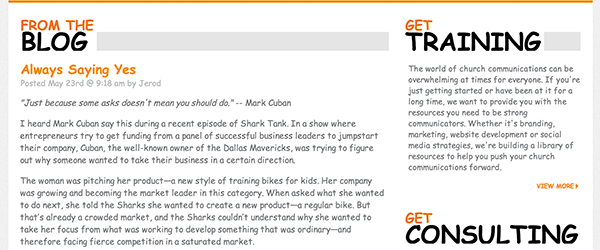There are two fonts in the design world that are equally despised: Comic Sans and Papyrus. And in the church world, these two fonts find their way into far too many publications. While I hold some ill-will toward these fonts, it has less to do with what they actually look like and more to do with how their being misused.
For our font enemy Comic Sans, the biggest issues comes when it’s used for anything other than children’s ministry. Microsoft commissioned the font in the mid-90s to mimic a comic book font. It was meant to be childish and informal.
Yet in a word processing world where people could choose something other than Times New Roman or Arial, Comic Sans started showing up in grown-up places that were supposed to be professional. Even today, I get emails from workplace adults that use Comic Sans and it’s hard for me to take them seriously. The same is true if you’re using a child’s font to promote adult parts of your church.
Here’s an example. I took a plug-in and turned Church Juice completely Comic Sans. It looked ridiculous. Could you really take us seriously if that was how it always looked?

I’ll give Comic Sans a bit of a pass for things directly used by children. But remember who’s actually reading those letters you send home from Sunday school. Parents.
Font lesson #1: Use fonts that are appropriate for the age of your audience.
Even if Comic Sans is age appropriate for a project you’re doing, you still have to ask if it’s the right font to use. Because so much is written about the disdain for this font, there will be some people that look at it and make a judgment. There are so many fonts available; it might be better to look at something else.
Font lesson #2: Understand certain fonts carry a stigma.
Our second font foe, Papyrus, carries a similar disdain. Much like Comic Sans, this font has made the “do not use” list because of its misuse as well. Designed as font to mimic calligraphy on old parchment a paper, this font became a go to for anyone looking to make something look old. That ranges from Mediterranean restaurants to churches.
Maybe churches were drawn to the font because it made them feel like going back to biblical times. I don’t know for sure. But now I think many non-experienced designers use it because it feels churchy. That might have worked 15 years ago, but in 2013, feeling churchy “Papyrus style” communicates you’re stuck in the past.
To combat the rougue use of fonts like Comic Sans or Papyrus in your church, have a style guide for what fonts are appropriate to use where. It should be part of your branding standards. There are times where certain design pieces use unique fonts, like a sermon series graphic, but most official correspondence should follow the branding guidelines.
Font lesson #3: Have a standard set of fonts for your organization and make people use them.
As you select the standard fonts for your church, there a good chance you’ll consider some tried and true fonts like Helvetica, Garamond, Gill Sans, Futura, Franklin Gothic and others. And I can hear some folks ask, “Aren’t those way over-used, too? Why is that any different from the overuse of Comic Sans?”
Yes, they’re being used often, but more appropriately.

The difference with the wide usage of Helvetica is the fact it’s designed to be sleek, neutral, easy to read and non-intrusive. The font isn’t trying to have some other intrinsic meaning. It’s not being used to try to be different. Instead, Helvetica is used because it easily communicates a message with no extra baggage. That’s why so many organizations and companies use it without getting a disgusted look from customer.
Font lesson #4: Some fonts get used over and over because they are well-designed classics.
A concept of basic design will tell you the fonts you use say something in addition to the words you type. Fonts have personality. Comic Sans speaks like a kid. Hanging out with Papyrus is like a trip to the old country. Helvetica is that well-dressed friend that doesn’t age and is always there for you.
If you’re charged with communication design at your church or organization, do it with purpose. Don’t pick a font on whimsy.
